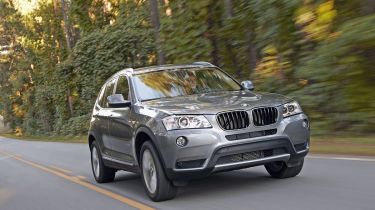BMW X3
Raft of changes makes SUV more spacious, stylish and comfortable
BMW has taken a fresh look at the X3 and rung the changes. The exterior has a more elegant appearance, while the attractive cabin offers class-leading space. On the move, the car has a more comfortable and laid-back demeanour, and is easier to live with. The four-cylinder diesel will prove fast enough for most, but we’d avoid the manual box and stump up for the eight-speed auto. Now a true all-rounder, the X3 more than earns its place in BMW’s line-up.
The X3 is coming of age! BMW’s all-new compact SUV is bigger and more powerful than the previous model. But it’s also lighter, cheaper and the most efficient car in its class. We went to Atlanta, near Spartanburg in South Carolina where the X3 is assembled, to see if this latest soft-roader has the X factor.
A stylish but less controversial design language is taking shape at BMW. It’s already been seen on the 7 and 5-Series, as well as the 6-Series that debuted at the recent Paris Motor Show – and the X3 is cut from the same cloth.
Video: watch CarBuyer's video review of the BMW X3
[[{"type":"media","view_mode":"content_narrow","fid":"68618","attributes":{"alt":"","class":"media-image"}}]]
Sharp edges and acute angles have been replaced by sculpted contours in the bonnet and doors and a sweeping tailgate that makes the model appear wider. While the last car’s proportions looked awkward, the new X3 is more elegant – a blend of the X5’s aggression and the flowing lines of the X1.
Used - available now

2022 Volvo
XC40
43,072 milesAutomaticPetrol1.5L
Cash £19,900
2018 Mazda
MX-5 RF
65,456 milesManualPetrol2.0L
Cash £12,500
2018 BMW
3 Series
74,919 milesManualDiesel2.0L
Cash £13,000
2026 BMW
3 Series Touring
11,392 milesAutomaticPetrol2.0L
Cash £29,600On the inside, build quality is flawless, but the real surprise is the space on offer. Rear legroom is generous, while a maximum load capacity of 1,600 litres is top of the class in an area not normally associated with BMWs. Yet despite an increased track, a longer wheelbase and extra room inside, the X3 weighs 25kg less than the model it replaces.
A head-up display projects stats about the car’s speed and sat-nav directions into the driver’s line of sight, while radar-based cruise control applies the brakes or throttle automatically to maintain a set distance to the vehicle in front. Plus, the ConnectedDrive system provides Internet access on the move.
Only one engine is available at launch for the diesel-loving UK market. But the xDrive 20d is a cracker. It has four per cent more power and consumes 15 per cent less fuel than the outgoing 20d – and it’s more than up to the task of hauling the X3 along.
Peak torque of 380Nm (that’s 30Nm more than before) means punchy in-gear acceleration, while the power delivery is surprisingly linear for a diesel. Refinement is impressive at motorway speeds, although the car becomes a bit noisy under hard acceleration.
A six-speed manual gearbox is standard, but it disappointed us with its rubbery feel and lack of precision. Fortunately, buyers can specify a superb optional eight-speed auto, which comes with a stop-start system – a first in this segment. The self-shifter suits the X3’s grown-up character better, too. And on the move the emphasis is on comfort – the car rides beautifully, rounding off any imperfections in the road.
But BMW hasn’t forgotten what it’s famous for: handling. Three modes – Normal, Sport and Sport+ – offer a variety of settings for the throttle response, power-steering weight, stability control, gearshifts and damper responses. The car is a capable cruiser and fun on country lanes, too. It even performed well on an undulating, but fairly smooth, off-road track.
BMW is keeping it simple for UK customers, offering only one spec at launch, alongside the single engine – although there’s plenty of kit as standard, such as leather trim and dual-zone air-con. The price is £115 cheaper than for the equivalent previous-generation car, but with costly options such as a panoramic sunroof, head-up display and sat-nav, the bill soon rises.



